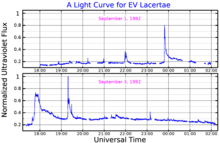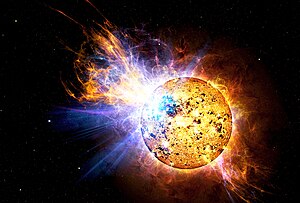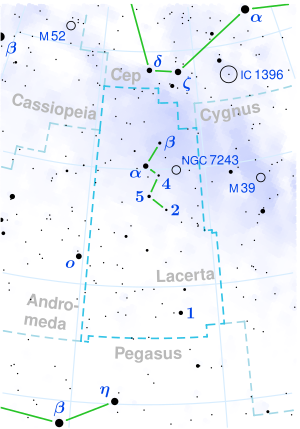EV Lacertae
| Observation data EpochJ2000EquinoxJ2000 | |
|---|---|
| Constellation | Lacerta |
| Right ascension | 22h46m49.7323s[1] |
| Declination | +44° 20′ 02.368″[1] |
| Apparent magnitude(V) | 10.09[2] |
| Characteristics | |
| Spectral type | M3.5[3] |
| U−Bcolor index | +0.83[4] |
| B−Vcolor index | +1.36[4] |
| Variable type | Flare star |
| Astrometry | |
| Radial velocity(Rv) | –1.5[5]km/s |
| Proper motion(μ) | RA:–704.65[1]mas/yr Dec.:–459.41[1]mas/yr |
| Parallax(π) | 197.9573 ± 0.0220mas[6] |
| Distance | 16.476 ± 0.002ly (5.0516 ± 0.0006pc) |
| Details | |
| Mass | 0.35[7]M☉ |
| Radius | 0.36[7]R☉ |
| Temperature | 3,400 ± 18[8]K |
| Metallicity[Fe/H] | –0.01 ± 0.17[8]dex |
| Rotation | 4.376 days[9] |
| Rotational velocity(vsini) | 4.5[7]km/s |
| Other designations | |
| Database references | |
| SIMBAD | data |
Location of EV Lacertae in the constellationLacerta | |
EV Lacertae(EV Lac, Gliese 873, HIP 112460) is a faintred dwarfstar16.5light yearsaway in the constellationLacerta.It is the nearest star to theSunin that region of the sky, although with anapparent magnitudeof 10, it is only barely visible withbinoculars.EV Lacertae isspectral typeM3.5flare starthat emitsX-rays.[10]

On 25 April 2008,NASA'sSwiftsatellite picked up a record-settingflarefrom EV Lacertae.[12]This flare was thousands of times more powerful than the largest observed solar flare. Because EV Lacertae is much farther fromEarththan the Sun, the flare did not appear as bright as a solar flare. The flare would have been visible to the naked eye if the star had been in an observable part of the night sky at the time. It was the brightest flare ever seen from a star other than the Sun.
EV Lacertae is muchyoungerthan that of the Sun. Its age is estimated at 300 million years, and it is still spinning rapidly. The fastspin,together with itsconvectiveinterior, produces amagnetic fieldmuch more powerful than that of the Sun. This strong magnetic field is believed to play a role in the star's ability to produce such bright flares. After the flare, thestarwasblue.[13]
In October 2022, another stellar flare was observed in EV Lacertae by a group of scientists led by Shun Inoue ofKyoto University,after observing the star innear-ultravioletandwhite-lightcurves.[14]The finding was announced and detailed in December 31, 2023, in the pre-print serverarXiv.[14]
References
[edit]- ^abcdPerryman, M. A. C.; et al. (April 1997). "The HIPPARCOS Catalogue".Astronomy & Astrophysics.323:L49–L52.Bibcode:1997A&A...323L..49P.
- ^"V* EV Lac -- Flare Star".SIMBAD.Centre de Données astronomiques de Strasbourg.Retrieved2010-06-12.
- ^Montes, D.; López-Santiago, J.; Gálvez, M. C.; Fernández-Figueroa, M. J.; De Castro, E.; Cornide, M. (November 2001)."Late-type members of young stellar kinematic groups - I. Single stars".Monthly Notices of the Royal Astronomical Society.328(1): 45–63.arXiv:astro-ph/0106537.Bibcode:2001MNRAS.328...45M.doi:10.1046/j.1365-8711.2001.04781.x.S2CID55727428.
- ^abErro, B. I. (1971). "Infrared photometry of UV CET stars".Boletin del Instituto de Tonantzintla.6:143.Bibcode:1971BITon...6..143E.
- ^Wilson, Ralph Elmer (1953). "General Catalogue of Stellar Radial Velocities".Carnegie Institute Washington D.C. Publication.Washington:Carnegie Institution of Washington.Bibcode:1953GCRV..C......0W.
- ^Brown, A. G. A.;et al. (Gaia collaboration) (2021)."GaiaEarly Data Release 3: Summary of the contents and survey properties ".Astronomy & Astrophysics.649:A1.arXiv:2012.01533.Bibcode:2021A&A...649A...1G.doi:10.1051/0004-6361/202039657.S2CID227254300.(Erratum:doi:10.1051/0004-6361/202039657e).Gaia EDR3 record for this sourceatVizieR.
- ^abcPhan-Bao, Ngoc; Martín, Eduardo L.; Donati, Jean-François; Lim, Jeremy (July 2006). "Magnetic Fields in M Dwarfs: Rapid Magnetic Field Variability in EV Lacertae".The Astrophysical Journal.646(1): L73–L76.arXiv:astro-ph/0603480.Bibcode:2006ApJ...646L..73P.doi:10.1086/506591.S2CID18410819.
- ^abRojas-Ayala, Bárbara; et al. (April 2012)."Metallicity and Temperature Indicators in M Dwarf K-band Spectra: Testing New and Updated Calibrations with Observations of 133 Solar Neighborhood M Dwarfs"(PDF).The Astrophysical Journal.748(2): 93.arXiv:1112.4567.Bibcode:2012ApJ...748...93R.doi:10.1088/0004-637X/748/2/93.S2CID41902340.
- ^Testa, Paola; Drake, Jeremy J.; Peres, Giovanni (December 2004). "The Density of Coronal Plasma in Active Stellar Coronae".The Astrophysical Journal.617(1): 508–530.arXiv:astro-ph/0405019.Bibcode:2004ApJ...617..508T.doi:10.1086/422355.S2CID17532089.
- ^Schmitt JHMM; Fleming TA; Giampapa MS (Sep 1995)."The X-ray view of the low-mass stars in the solar neighborhood".Astrophys. J.450(9): 392–400.Bibcode:1995ApJ...450..392S.doi:10.1086/176149.
- ^Abdul-Aziz, H.; Abranin, E. P.; Alekseev, I. Yu; Avgoloupis, S.; Bazelyan, L. L.; Beskin, G. M.; Brazhenko, A. I.; Chalenko, N. N.; Cutispoto, G.; Fuensalida, J. J.; Gershberg, R. E.; Kidger, M. R.; Leto, G.; Malkov, Yu. F.; Mavridis, L. N.; Pagano, I.; Panferova, I. P.; Rodono, M.; Seiradakis, J. H.; Sergeev, S. G.; Spencer, R. E.; Shakhovskaya, N. I.; Shakhovskoy, D. N. (December 1995)."Coordinated observations of the red dwarf flare star EV Lacertae in 1992".Astronomy and Astrophysics Supplement Series.114:509–526.Bibcode:1995A&AS..114..509A.Retrieved14 January2022.
- ^Dunbar, Brian (May 20, 2008). Smith, Yvette (ed.)."Pipsqueak Star Unleashes Monster Flare".NASA.Retrieved2010-06-12.
- ^"- YouTube".YouTube.
- ^abNowakowski, Tomasz; Phys.org."New large stellar flare detected from EV Lacertae".phys.org.Retrieved2024-01-11.


